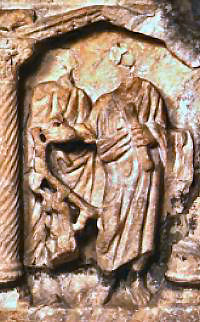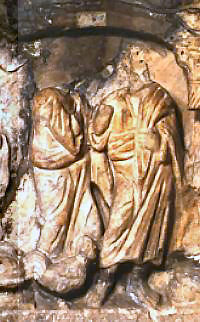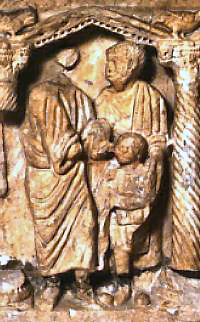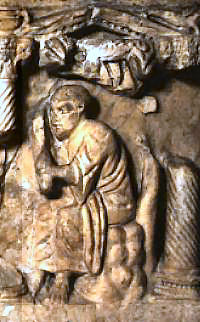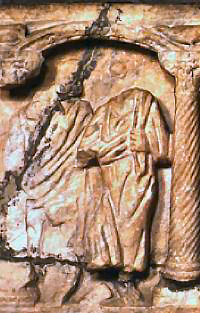The
Paleo-christian Sarcophage of Salles
Upstream from Balazuc, in the hamlet of Les Salles,
during agricultural work, in the XVIth century, was found a marble sarcophage,
white with black veins. It was kept in the church of Saint-Maurice which is
in the parish of Les Salles, until its transfer in 1858 to Lyon. This was due
to the Bishop of Viviers expelling it from the church as he considered it a
pagan relict.
The ancient Roman road from Uzès to Alba passes through Les Salles. Remains
of the old Bornes milliaires or « milestones » can still be seen at Saint-Germain
and Pradons. In the Midi, quite a large number of these sarcophages have been
found, often made in Arles Stonemason's yards, at the end of the IVth and Vth
centuries.
First
Scene :
Two men wearing the « talaire » tunic (which goes down to the heels) with wide
sleeves. At the foot of one, can be seen the legs and thighs of a seated child
with a broken body. Some think this represents Christ accompanied by an Apostle,
bringing back to life the son of the widow of Naim.
Second
Scene :
Two standing figures wearing the talaire tunic. Their heads have been broken.
On the right, standing slightly to the rear, could be Daniel, who poisoned the
dragon, of whom remains only le lower part coiled up round a tree.
Third
Scene :
Christ, accompanied by an Apostle,
cures the paralysed man. He holds out his hand telling him to take up his bed
and walk. Below Christ’s hand can be seen the paralysed man, cured, taking up
his bed.
Fourth Scene :
Two headless figures represent Christ and Saint Peter. Christ is on the left
and Saint Peter has a cock at his feet. Christ is announcing to the chief of
his Apostles that he will deny him three times.
Fifth
Scene :
This shows one of Christ’s miracles that of the cure of a children blind from
birth. There are three standing figures. To the left, the blind man, on whose
eyes Christ is laying his hand. Christ is to his right, his hand and forearm
are broken.
Sixth
Scene :
Two Roman soldiers with bushy hair are standing. They are wearing tunics and
sandals. Their heads are turned to the left, the first one points with his arm
he personage in the following scene. It is the arrest of Saint Peter.
Seventh Scene :
A bearded figure is sitting on a rock, leaning against a tree. He wears a tunic,
his hair is short. He holds with both hands a scroll on which his eyes are fixed.
This represents the Pulpit of Saint Peter. Saint Peter is preaching, from a
rock and holding a scroll of the Holy Word.
| This rare object can be
seen in the Museum of Gallo-Roman Civilisation in Lyon. A replica can
be seen in the courtyard of the Balazuc Town Hall. |
These
workshops produced Christian tombs with Bas-reliefs representating scenes from
the Old and New Testaments. It was the burial of a noble man, secular or ecclesiastical,
who have be buried in a possibly pagan cemetery.
Size of Sarcophage:
Length: 2.28m
Width: 0.72m
Heigth: 0.58m
Weigth: 1,190kg |
